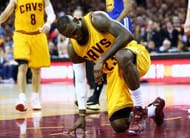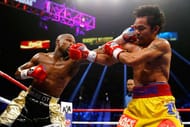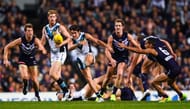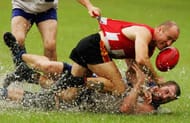8. Basketball
Basketball, when it’s played the way it’s meant to be, is like a levitating orchestra – with the players' feet barely skimming the ground while they float above the earth for 40 hard minutes. It is one of the fastest team sports played on solid ground, involving an incredible amount of straight sprints, jumps, lunges and contact at a very fast pace.
Technically, it is a non-contact sport. But anyone who's seen or played the sport knows that that classification is a bit of a joke. No sport presents you with the prospect of such a variety of injuries as basketball does. From overuse injuries, tendonitis, ACL tears and bursitis to sprains, fractures, cramps and ligament tears, the list is endless.
Fatigue contributes heavily towards injuries; when the body overcompensates for depleted energy levels, it becomes more vulnerable to damage. Basketball players can have vertical leaps measuring over 30 inches, and most of them are above 6"4 in height. That makes for some explosive action on the court, which can be brutally exhausting.
In a study published recently by Sports Illustrated, LeBron James beat Cristiano Ronaldo and Usain Bolt to be named the fittest athlete across all sports. Basketball requires an extremely well-toned cardiovascular system, explosive anaerobic power, ample muscular strength and endurance, and low body fat.

Players like LeBron and Russell Westbrook rely a lot on their explosive fitness to dominate the competition, and they often have to push themselves beyond the point of exhaustion. Dribbling, shooting, playing defence, etc all involve using the upper and lower body in tandem. And that's not to mention sprinting up and down the court without respite.
The sprints don't stop once the players reach one end of the court either. Watching a player like JJ Redick run around in the half-court is exhausting by itself.
If you observe the training habits of some of the players, you'll be forced to question the humanity of the punishing ordeal they put themselves through. From Kobe Bryant going on 40-mile-long midnight cycle rides through the desert, to Blake Griffin climbing sand hills with weight vests, the players undergo brutal training regimens to cope with the demands of the sport.
Let's take a look at the players who cover the most ground during matches. Luol Deng covered 2.72 miles per game in the 2012 season, and Jimmy Butler covered the same amount in the 2015 season. That translates to 4.3 km.
Now, the basketball court is 94 feet long, translating to 28 metres. If Deng and Butler cover 4.3 km per game, that must be equal to 153 trips up and down the basketball court, most of it covered in sprints, all within a space of just 48 minutes. Moreover, a lot of the distance covered is with a defender being glued to your hip or with you shadowing another player at whose whims and jukes you have to change direction.
There's a good reason you see basketball players looking winded and soaked in sweat all the time.
Calories burnt per minute: 9.37
Sweat loss per minute: 0.02 litres
Duration: 40 minutes
7. Boxing
There is a world of physical pain and punishment awaiting a boxer within that 20 square feet purgatory enclosed by four parallel ropes.
Boxing is generally considered to be more of a bruising sport than an exhausting one. But as it turns out, performing an intense cardio session while plummeting a well-conditioned machine and trying to avoid getting beaten to a pulp makes for a shockingly draining workout.
A study analyzing seven Olympic boxers showed that their peak punching force ranged from 447 to 1,066 pounds. Another study involving 70 boxers showed that they hit with an average of 776 pounds of force. 1985 World Boxing Council heavyweight champion Frank Bruno could throw a punch with a force of 1,420 pounds, which if connected with the head of an unfortunate opponent would send the latter reeling at a rate of 53 g, i.e. 53 times the force of gravity.
There is no mitigating the effect of such well-trained blows raining down on your person.
Before the powers that be decided on a 12-round limit, matches could go on indefinitely; until 1867, boxing would have been a lot higher on this list. The Marquess of Queensberry rules helped bring the rounds down to 12 and set the duration at 3 minutes per round. There's generally a one-minute break between the rounds.
A boxing match can also get over in fewer than 12 rounds in case of a knockout or if one of the fighters is unable to continue. That's a total maximum duration of 36 explosive minutes of timed action in which the fighters expend every ounce of their energy.
How many punches can be thrown in a round of three minutes? In the 12th round of a fight between Vince Phillips and Ray Oliveria in 2000, the two fighters were so tired that they barely bothered to dodge punches. Instead, both plugged away with the last remnants of their stamina while absorbing body blows. They threw a combined 463 punches in that round.
Boxing is not just about how hard you can hit; it’s also about how hard you can get hit and then choose to get hit again, and again, and again. It's a test of how much risk of permanent bodily harm you can take.
In times of stress, people are encouraged to take deep breaths. Even panic attacks can be calmed by breathing deeply. And a really quick way to get exhausted is to interrupt your breathing.
When you take a hit in boxing, your breathing gets interrupted and your muscles get compromised, so there is almost constant cause for exhaustion in the sport. Moreover, in the case of a punch to the head, the brain comes into contact with the skull and gets twisted. There is risk of brain haemorrhage, detached retinas, concussions – the list goes on.
Nothing tires you out as quickly as a full blown sprint or a suicide drill. Boxing involves a number of sprinting lunges, all taking place while the upper body performs a strong set of cardio. Each movement can require you to expend close to the maximum energy possible as you dodge, bob and weave and throw punches.
Boxing can leave you battered, bruised, gasping for breath, disoriented and uncertain about the purpose of your existence.
Calories burnt per minute: 14.5
Sweat loss per minute: 0.03 litres
Duration: 32 minutes
6. Australian Rules Football
To the layman's eye, rugby, American football (National Football League, USA) and Australian Rules Football (Australian Football League, Australia) seem homogeneous to a large degree. What all three sports have in common is the objective of striking your opponents hard, with the aim to floor them.
But the technicalities of the three sports present a stark contrast, and a process of elimination can help us determine which of the three is the most exhausting.
NFL
There's no question that NFL athletes are way more powerful than their counterparts in the AFL and rugby, but that is because they need to prepare for action in short bursts.
The actual time when the ball is in play in an NFL game is barely 11 minutes. While there is a world of pain packed in those 11 minutes, it doesn't compare with Australian rules and rugby. On an average, an NFL player covers about 2 km per game.
Australian rules and rugby involve minimal protective equipment compared to the NFL, and both those sports require the athletes to cover way more ground while colliding with muscular, rhino-skinned warriors.
Rugby vs Australian rules
A rugby player can cover between 4.5 to 6.8 km in a match on an average, while spending roughly 75 to 91 minutes on the field. Compared to that, an Australian rules player can cover between 10 to 18 km per game and burn over 1,000 calories per hour.
A rugby match lasts for 80 minutes, divided into two halves. The AFL has 20-minute quarters, but it places more aerobic demands on the athletes.
In Aussie rules, you can only pass the ball by kicking or punching. And the players need to constantly run for their lives while evading tackles, leaping for catches (or taking a mark, as the parlance has it), torpedoing into tackles, breaking tackles and traversing a field way larger than a football field.
(An AFL field can be between 135-185 metres long between the goals and 110-155 metres between the sides. In contrast, a football field is just about 105 metres long and 68 metres wide).
The AFL also has tremendous potential for violence, with tackles being allowed on the player who has the ball. Players are also allowed to use force to prevent their opponents from tackling their team members. That rule has wide room for interpretation, and teams use every bit of their imagination to perform the most painful contact they can get away with.
Each of these three sports involves explosive, hard collisions between colossal, sprinting masses of muscle. The NFL features the hardest hits, but has minimal on-field action. Rugby has brutal, violent and pad-less hits, but is primarily an anaerobic sport. Australian rules edges out in front because of the hard hits and runs it demands.
Calories burnt per minute: 10.71
Sweat loss per minute: 0.03 litres
Duration: 80 minutes
What is the foot injury that has troubled Rafael Nadal over the years? Check here




